
Outlanders Equipment
Page Version 1.04
The Deathbird AKA AH 64 Attack Helecopter

Pictures and Data Compiled by Rodney Moorehead
Hughes AH-64
Model 77, AH-64
Origin: Hughes Helicopters, Culver City, USA.
Type: Armed helicopter.
Engines: Two 1,536 shp General Electric T700-700 free-turbine turboshafts.
Dimensions: Diameter of four-blade rotor 48 ft (14.63 m); lenght overall (rotors turning) 57 ft 9 in (17.6 m); length of fuselage 49 ft 5 in (15.06 m); span of wings 16 ft 4 in (4.98 m); height (to top of hub) 12 ft 6.75 in (3.83 m).
Weights: Empty 10,268 lb (4657 kg); maximum loaded 17,650 lb (8006 kg).
Performance: Maximum speed (13,925 lb/6316 kg) 192 mph (309 km/h); maximum cruising speed 182 mph (293 km/h); max vertical climb 2,880 ft (878 m)/ min; max range on internal fuel 380 miles (611 km); ferry range 1,121 miles (1804 km).
Armament: Four wing hardpoints can carry 16 Hellfire missiles or 76 rockets (or a mix of these weapons); turret under fuselage (designed to collapse harmlessly upwards in crash landing) houses 30 mm Chain Gun with 1,200 rounds of varied types of ammunition.
History: First flight (YAH-64) 30 September 1975; entry into service scheduled 1984. (note: actually the first Apache entered service in 1986)
User: USA (Army).
"Hughes is responsible for the rotors and the dynamic components, while Teledyne Ryan produces the bulk of the rest of the airframe (fuselage, wings, engine nacelles, avionic bays, canopy and tail unit). The entire structure is designed to withstand hits with any type of ammunition up to 23 mm calibre. The main blades, for example, each have five stainless-steel spars, with structural glassfibre tube linings, a laminated stainless-steel skin and composite rear section, all bonded together." (however, on the next page the text says: "The entire aircraft is designed to withstand hits from 12.7 mm (0.5 in) projectiles, and most crucial parts are designed to withstand 23 mm (0.9 in).")
AH-64 Apache's 30 mm chaingun can kill a tank from 1.5 km and the Hellfire-missiles have a range of 6 km. Apache's newer version, AH-64D Longbow Apache can use radar-guided Hellfires, which can be fired in "fire and forget"-fashion. As far as I know, the main differences between AH-64 and AH-64D are the millimeter-wave radar system and related subsystems and engines. AH-64 Apache appears in many computer simulations: AH-64D Longbow and (the good old) LHX Attack Chopper by Electronic Arts, Apache Longbow and Longbow 2 by Digital Integration, Gunship and Gunship 2000 by MicroProse, etc. It has also appeared in many movies.
Lakesh's Prototype Interphaser
Lakesh designed a special device whose main purpose was to harness and use the naturally occurring gateways located across the globe, without having to rely on the Totalitarian Concepts Mat Trans system. He brought the device out to experiment with in Savage Sun.
The device resembled a squat, broad based pyramid made of smooth, dark metal. The device was barely a foot in width, and no more than ten inches in height. It had two input ports, one for a keyboard to set destinations.
This Prototype was used to get Kane, Domi, Grant and Brigid back from England after they had been trapped inside Lord Strongbow's laboratory after defeating him. There were some very unusual side effects from the jump.
Subdermal Transponder
Lakesh designed a special transponder to monitor the location of the Cerberus personnel via a satellite that they had access to. The transponder would locate the person in question and even indicate the persons vitals. The transponder is made up of a harmless radioactive chemical that bonds itself to the glucose in the blood system in the middle layer of the epidermis. It is based on organic nanite technology. It transmits heart rate, brain wave patterns, respiration, blood count and so forth. The injections show up under infrared light and appears to be the three line symbol on the front of each Outlanders Cover.
Magistrate Uniform
The uniform and badge of office for the Magistrates consisted of a black, kevlar-weave overcoat that was ankle length. The coat could stop most small arms from penetrating, as well as other weapons like knives and the like. The right (or Left) sleeve of the overcoat was larger than normal to accommodate the Sin-Eater.
To top of the ensemble the Magistrates wore black, fingerless gloves, black combat-style boots, and black sunglasses. The overall impression was to exude authority and more than a little menace, to cause outlanders and ville inhabitants alike to almost instinctively fear anyone dressed in the uniform.
Magistrate Hard Contact Body Armor
The body armor worn by the Magistrates who ventured into the Tartarus pits, or into the Outlands consisted of a Kevlar under-sheath. Attached to the under-sheath were joints of black polycarbonate body armor. The armor was molded to conform to the wearers biceps, triceps, pectorals and abdomen, Thighs and calves. It made it very difficult, if not impossible to seriously injure or kill a Magistrate who wore the armor.
The armor included black armored gloves and combat boots, and for even more added protection the Magistrate overcoat could be worn.
Included in the Armor was a black helmet, with only the mouth and chin exposed. The helmet provided low light capabilities as well as communication between the magistrates. It was molded to fit individual magistrates, and was light weight.
Overall, the entire suit of body armor was pitch black, with the only spot of color showing anywhere being the badge of office, worn over the left pectoral.
Mnemosyne
This device, commonly known as the Syne, is a lock decrypter. It was shaped like an elongated circle divided down the center by a thread thin slit. The device when attached to a disc or electronic lock, would quickly bypass any locking code, encryption or combination and allow access. It very rarely fails.
Shocksticks
These devices were commonly used by Magistrates for crowd control in the Tartarus pits. It was simply a long baton under three feet in length, powered by batteries. The batteries were located in the hard, molded grip. The end had two small prongs that when came in contact, delivered a powerful 6000 volt jolt, quite effectively incapacitating anyone hit by it. The device could also be used as a melee weapon. Mentioned for the first time in Savage Sun.
Hand held Motion Detectors
First discovered in Savage Sun, this small device was made of molded plastic and stamped metal with an expandable band. The face was a liquid crystal, digital display window that showed a throbbing green disk. Which ever way the device was turned, the disk would turn as well. A number of small buttons were attached to it to work the device. They existed before the Skydark, and were stored in stockpiles. Even though, only a handful made it to each of the baronies.
The Cromwell
A corvette class warship, it displaced 114 tons and had a top speed of over fifty knots on smooth seas. It was a sleek, sharp prowed vessel, painted a flat, sinister black. Its streamlined, oddly faceted contours gave it the appearance of a gigantic knife blade.
Weaponry consisted of 3, 40mm cannons placed amidships, the barrels jutting out from behind metal shielding. Also present was an Exocet anti ship missile system and a BOFORS deck cannon, a pair of tripod mounted L7-A1 Heavy Caliber machine guns, and even a Limbo anti submarine depth charge launcher.
Power came from a regenerative gas turbine engine with back up diesel engines.
The ship was one of the first to ever use the ocean stealth technology, and the UK only produced a handful of them before the Skydark. The were used during the Falkland war.
Mention in Savage Sun and Hell Rising.
A real life Stealth Ship below: As usual, all links and information kept strictly as is, in the chance that the page might eventually be removed from the net.
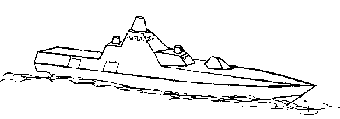
In 1988 the Swedish Navy started planning for the acquisition of two new ship classes, corvettes of types YSM (Ytstridsfartyg Mindre = Surface Combatant Small) and YSS (Ytstridsfartyg Större = Surface Combatant Large).
The very successful trials with the test stealth ship Smyge gave a lot of knowledge that was applied to the YSM project.
Due to economic considerations, YSM and YSS became a single ship, YS2000 (Surface Combatant 2000), in 1993. The original plan called for two versions of YS2000, series 1 primarily an ASW platform and series 2 slightly longer with SSM and SAM as well as a helicopter hangar allowing a helicopter to be permanently stationed aboard.
After nine years of development work, the Swedish government in 1995 ordered two ships from Karlskronavarvet AB, to be delivered in 1999 and 2000, from series 1, with an option on two more.
Construction started during autumn 1996.
In Aug 1999, a further two were ordered, bringing the total to six.
The lead ship, Visby, was launched on June 8:th 2000. After trials it will enter full operational service in 2004 with Andra ytstridsflottiljen (2. surface attack) based outside Stockholm. The remaining five ships will be delivered with one year intervals.
K 31 HMS Visby K 32 HMS Helsingborg K 33 HMS Härnösand K 34 HMS Nyköping K 35 HMS Karlstad K 36 HMS Uddevalla
Missions for both the military and civilian arm of the Swedish defense forces include command, surveillance, anti submarine warfare, mine hunting and international missions.
YS2000 is a fully stealthed design with weapons and workspaces behind hatches, low concealed exhaust pipes to minimize IR signature and a completely unmagnetic hull similar to the Landsort class minesweeper. All work with weapons and mines is conducted inside the ship and it is impossible to see which weapons are carried from the outside.
The hull is designed especially for waterjet propulsion and is built and designed in three sections. The carbon fiber reinforced plastic hull is very light and unmagnetic.
There are no known foreign counterparts to YS2000.
Speeds: 18 knot cruise, 35+ knot maximum
Length: 72.8 m
Width: 10.4 m
Depth: 2.40 m
Deplaces: 600 tons
Engines: Diesel and gasturbine designed to minimize
noise.
Low speed, 0 - 14 knot, two diesels, 2.6 MW together
High speed, 0 - 35-40 knot, four gas turbines, 16 MW
Propulsion: Waterjet. Swedish KaMeWa is world leading
in waterjet propulsion and seem a likely
candidate to supply the propulsion systems.
Sensors: Passive TAS (Towed Array Sonar), active VDS
(Variable Depth Sonar), active hullsonar,
sonar and camera equipped ROVs.
Surveillance and navigation radar and ESM.
Weapons: 40 cm ASW torpedos, ASW grenades,
57 mm AA automatic cannon,
mines and RBS 15 anti ship missile.
Information from Marinnytt nr 2 1995, Ny Teknik
1995:42 and courtesy Karlskronavarvet AB.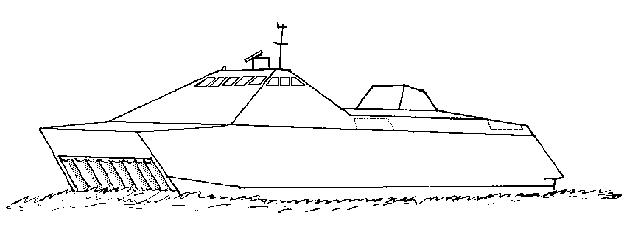 The Swedish stealth ship HMS Smyge is a purpose built test platform for
developing stealth technology, test new weapon systems, sensors, communications
systems and navigatin equipment as well as gaining experience with surface
effect ships (SES).
The Swedish stealth ship HMS Smyge is a purpose built test platform for
developing stealth technology, test new weapon systems, sensors, communications
systems and navigatin equipment as well as gaining experience with surface
effect ships (SES).
It was first shown publicly in 1991. During the following years it was trialled in many regards (for example there is no deck to stand on).
It is not a prototype for our next generation combat vessels, also beeing built by Karlskronavarvet AB, for one thing it is too small, and the weapons fit is not representative for a ship this size, but it has a little of everything for evaluation purposes.
Configuration is a side-keel hovercraft, or SES - surface effect ship, mostly manufactured of kevlar and glassfibre.
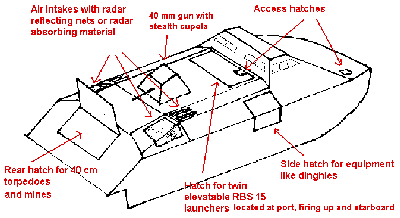
It is designed to reduce radar, IR and noise signatures. All structures consist
of angled flat surfaces and all in- and outlets are screened or fitted with
radar absorbent material, the engines' exhausts are cooled, using three
different methods to evaluate them, and the use of water jets makes for a small
noise signature.
As only very little of the hull projects into the water (more than 80% of the ship is supported by the air cushion), it makes for a small pressure signature (there are Norwegian mine hunters with the same configuration). This also makes it relatively insensitive to underwater explosions.
It has conformal and retractible antennas,
including the elevating radar mast.
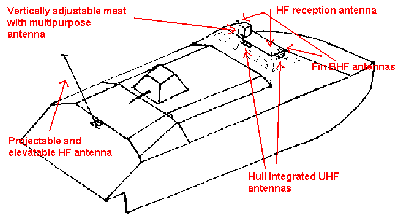
Displacement: 140 tonnes
Length: 30.4 m (27 m waterline)
Beam: 11.4m
Draft 1.9 m at rest; 0.7 on the air cushion.
Speed: More than 40 kt in calm weather
Crew: 14 (6 officers and 8 conscripts)
Propulsion: Two 2040 kW MCR diesels powering
KaMeWa Waterjet "63" water jets
Lift: Two 460 kW Scania DSI 14 diesels powering
the lift fans
Armament: 40 mm gun type TRINITY
The barrel can be depressed into the hull
and covered by a hatch.
Two RBS 15 anti-ship missiles
Torpedoes
Mines
Anti-submarine warfare equipment
Mine counter measures equipment
The mast is there to comply with civilian regulations regarding lights etc. It also camouflages the stealthyness so that all other trials can be performed in view of the public. It is easily removed for stealth trials.
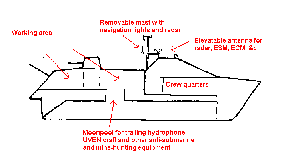
There is an open shaft located at the ship's centre of gravity from the hold
down to the water, a "moonpool". This reduces forces on equipment
deployed, for example hydrophones, UVEN craft and various anti submarine and
mine hunting equipment.
The Smyge text written before 1994, last modified 1996 May 03, The Visby text written 1995, updated 1996 May 03, 2000 July 07, images created in 1995 and 1996. Document last modified 2000 July 07 by Urban Fredriksson
The Sandcat
Mark Ellis based this vehicle on the one shown below. Data taken from the following page: http://www.marcav.ctc.com/projects/m113/index.htm All links retained.

The goal of this project is to upgrade the existing electric drive M113 personnel carrier to improve performance and space efficiency. Activities include: design and fabrication of an advanced lead acid battery-based energy storage system, a 55 kW Auxiliary Power Unit (APU), a distributed network-based vehicle power management system, installation of these components and a low noise band track into the existing electric drive M113, and support to subsequent testing and vehicle demonstrations.
Organo Metallic Synapse
This device is used to record and replay memories from the human brain using a computer interface. The device, attached to a computer, consisted of what appeared to be a chrome plated serpent, with metallic spider like legs sprouting from the head. The device would latch onto a victims face, settling in over the cranium and using the spider like legs to dig in and hold on. From this device memories could be literally downloaded and displayed on a computer screen, although it would take a lot of time for the computer to untangle the jumble of mis-matched memories and thoughts. Given time, it could do so eventually.
The device wasn't designed to be pleasant, as it was invasive, forcing small tendrils into the victims head to search out the memory sections of the mind.
By using this technology, the Barons could interrogate anyone and get any information they so desired, no matter what sort of training against torture and interrogation the victim had. All it required was time.
First mentioned in Omega Path
Robotic Surgeons
The barons use robotic surgeons instead of human or hybrids for their personal care. That way they are 100% loyal and can not make any mistakes.
The robots were designed to mimic human appearance, but that is all. The bodies were metal and chrome, the skull similar to a humans, with small red photoreceptors where the eyes would be. The jaw was filled with silver teeth, the neck corded with tubes and hydraulics. The chest was un-usually broad because it had to house the robots computer controls.
One hand was replaced with surgical instruments, which in a crunch, could be used as make shift weapons.
In some ways it resembled the Exoskeleton from the Terminator movies.
First mentioned in Omega Path
Molecular Destabilizers
This weapon was still in the experimental stage when the Skydark occurred. The ones used by the Transadapts during their exploration of the Earth side redoubts appear to be a dark metal ovoid on wheels. It was controlled using a remote. When activated and ready for use a white halo shimmered above the storage rings to the rear. A deep red light shone from the deep recessed firing lens.
The weapon uses energy to break down the molecular bonds that hold molecules together, literally disintegrating the target, but not dispersing the molecules. Instead, the results appear as if the target had been subjected to an acid bath, the molecular soup spread out all around. The firing of the device could be controlled so that there was little chance of collateral damage.
Encountered in Parallax Red.
Created on 08/14/98
Updated on 09/15/00